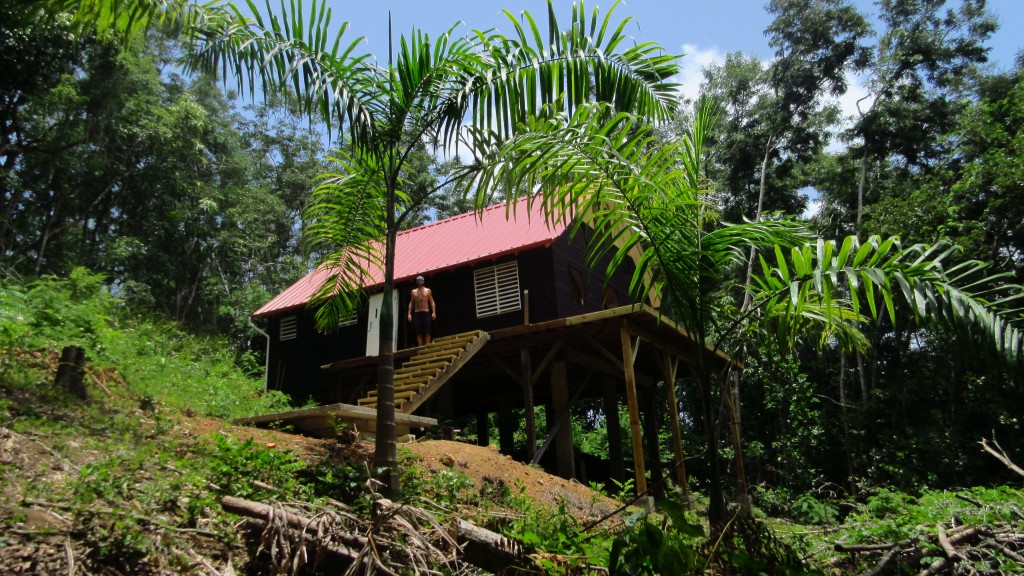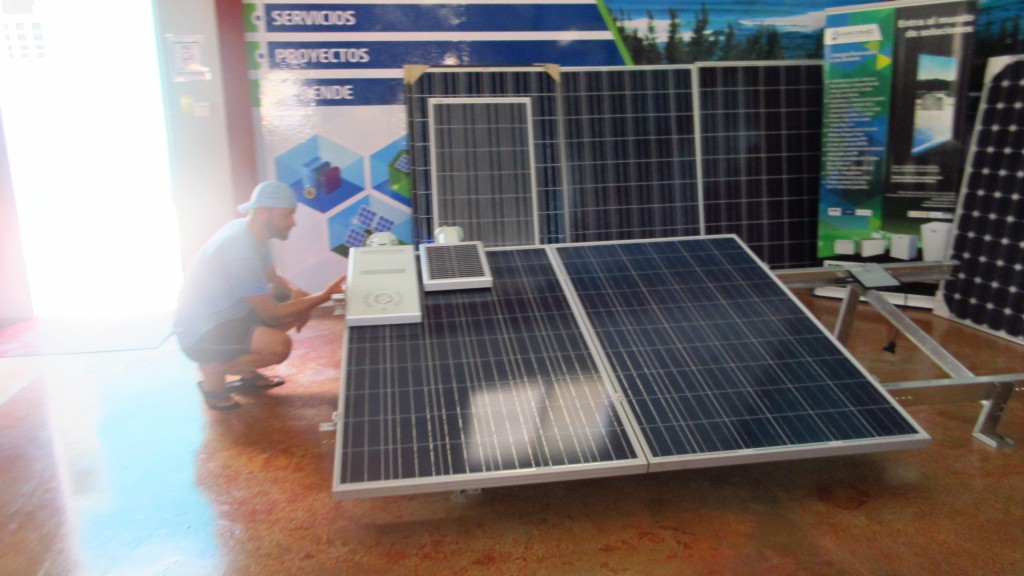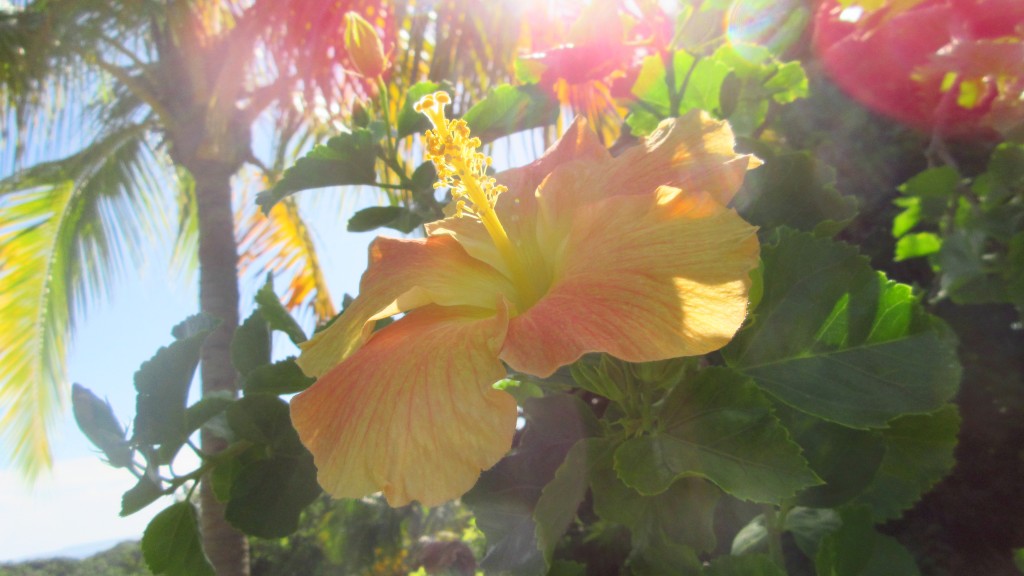The cabin is coming together nicely. We have been chugging through some of the tasks that we can tackle on our own like the tar paper, hurricane clips, lag bolts, collar ties, the stairway and making new trails.

Cabin Currently with stairs and tar paper
We are always thinking and planning two or three steps out, however. We are trying to decide what to do for siding and windows and doors. But the big question that has been on our mind is should we go with solar energy or regular grid-tie energy.
When we first started building the cabin we thought solar was our only option since the cabin is so far from any road and tucked up in the jungle. Then we talked with the electrician who built our pedestal and moved the electricity from the old wood house to our cabana and he said he could do it. And all underground too! No unsightly wires hanging in the trees. So this gave us a second option. We have done some research online and visited some solar stores in Puerto Rico as well. But we are still having a hard time making a decision.

Britton checking out some solar panels in Puerto Rico
Each option has its pros and cons and they sort of cancel each other out.
Here are the pros for each option as we see them:
Pros for Regular Electric:
Cheaper to set up (at least half the cost)!
Can use as much electricity as needed without worry of running out
More familiarity
Easier to connect for expansion/building other things
Done by professional -one stop shopping and less hassle for us
Not as many parts to understand/fix if they break
No load on the roof for the panels
Aesthetics (no panels showing)
Pros for Solar:
Not dependent on the expensive energy of Puerto Rico which is currently around 30 cents KW -one of the highest costs in the U.S. and abroad
Make us more conscientious about energy usage if we only had so much
Off-grid living at its finest
Latest technology
Eco-conscious/green
Learning opportunity
Could be used in other applications as well
Never have to worry about power outages when everyone else loses power
We were actually just about set to do solar, but then we saw the price tag and how little energy it would actually generate. From Maximo Solar in Aguadilla we got a quote for about $6000 for 1.5 KW/day (assuming 5.5 hours of sunlight). This included pretty much everything including the batteries, inverter, panels, charge controller, and wires. But it did not include the mounting hardware or the battery rack and it did not include installation (which would mean a big learning curve for us).
The most energy efficient fridges use about 1 KW a day and all the other appliances (lights, fans, laptop, point-of-us water heaters, etc) would probably fall under the rest, but we would need to be very energy conscientious. This isn’t necessarily a bad thing, but leaves little wiggle room for a long stint of cloudy days though Rincon is sunnier than many other places on the island. We found other systems online that are slightly less costly, but the shipping to Puerto Rico is outrageous (a rant for another day!).

We could all learn more from plants: the ultimate solar energy converters
So we are still sort of weighing the pros and cons and thought we’d put it out there to see if there were any other perspectives we were missing. One of our friends said to do whatever it takes to get solar in order to get out from under AEE’s (the Puerto Rico Electric Company) thumb. But we really haven’t had that much of a problem with them. It’s a tough call. Hmmm. What do you think?

We’ve had an “on grid” solar system for 12 years now and have saved about $ 2,500 annually on what would now be a $15,000 installation (it was twice as expensive when we installed as early adopters) for 6 kw system on our 4,000 sq.ft home . We like having both, because our electricity is dependable , the grid bills are very low (mostly taxes, around $12 a month up to $50 in high use time (running a 220 hot tub in the winter during poor weather), and we save about $200 a month on grid charges, even though electricity is cheap in Utah for now. We have a battery backup in the garage (recycled telephone company batteries) which you probably don’t need. We like the independence of solar and maintenance has not been a problem, especially if there is some support once in a while (only had problem with inverter when Larry accidentally hit it with a hose!). So don’t know if you want to opt for both solar and grid, but we have found that in the long run it is economical and nice to never run out of electricity . The solar will pay for itself and the grid is a cheap backup.
Hello Brit and Kassie,
I would check the warranty for the solar system.in areas close to the ocean,there is salt mist in the air,and it corrode things way faster than inland…
Also ,the aesthetics would be in issue.
And you truly will not want any air conditioning? I live in Florida,and coming here from Seattle,and can’t imagine taking the heat without any breaks…..
Thanks for your thoughts, guys.
Annie, it is definitely an either/or option. The cabin is pretty far from our cabana and so just digging and running the line will be quite the feat, though they can use aluminum for part of the run instead of copper so it wouldn’t be as much as we initially thought. I think once we have either type we’d be unlikely to want to spend the money and time doing the other as well. In either case, however, we use so little electricity that our bills will hardly be affected. We only spend about $15-20/month total on electricity currently.
Vera,
At the cabin we are planning on having lots of fans and maybe misters outside, but definitely no air conditioning. Perhaps when we build a larger concrete house we will consider it for resale or rental purposes. But at 30 cents/KW it really adds up. We have become acclimated to the hot summers and have learned the value of shade, cold showers and going to the beach when it becomes just too much! We also have no dryer and sun dry all of our clothes. A truly simple solar solution. And it saves a lot of energy!
As for sea salt: We are probably right on the line where salt could be an issue…about 3/4 mile as the crow flies from the nearest beach. We don’t have the sort of corrosion that beach front houses would have though.
Thanks for the added insights, keep ’em coming!
If I was building a home I would recommend both but I relies this will be expensive. If you do decide to go with PRPA I’m not sure how far you are going from the meter but make sure you have a heavy enough gage wire because of the voltage drop. I know copper is expensive but much better than aluminum as a conductor. Good luck on what ever you decide to do.
Where will you put the panels? Does your roof face south? What angle is it? Panels should face south and be at your latitude (18) degrees unless you want to change them throughout the year then (+/-15 degrees).
Due to clouds your solar hours will be 4.4 maybe a touch more because Rincon may be dryer than San German. 1.5KWH is basically camping. Your fridge will take most of that. Shoot for at least 3KWH a day.
An off grid system is marginally eco friendly due to the batteries but the batteries can be recycled fairly efficiently. Off grid costs way more but you don’t need any inspections from the Prepa. Lead Acid batteries should not go below 50% charge. Ideally you only should use 25% of their capacity so they will last many years. That just made your 3KWH a day system require 12KWH of storage but then you should factor in a cloudy day or two. Funny though because you really only need about $1000 worth of panels. It’s everything else that’s expensive. LOL, go all DC and forget the inverter like on a boat.
Prices of panels are way cheap now but everything has stayed the same. Too bad you can’t make use of the 30% tax credit. PR has some incentive but IIRC it’s basically a lottery now so don’t count on it.
Your best is just to come off the breaker box from your cement cabana and run a 20 amp 115 volt line to your new house. You could do that without anyone knowing but technically you will need a permit for that. Then get a Honda EU2000i generator for those times the power is out and call it good.
You guys use so little power you really can’t get any greener. Solar is a great option under certain circumstances. If you guys really want to try some solar then try to find used equipment for real cheap. Lots of people who tried solar long ago had their batteries give out and they gave up. They still have the panels and inverters doing nothing. Just make sure you know what you’re looking at. Used batteries are only worth scrap prices for the lead.
Hi Jeff!
The panels would be roof mounted to the south. Not sure exactly what angle it would be but with an adjustable or homemade mount it could be tuned a bit.
You bring up a lot of the main points that we are having trouble with. To get a reasonably sized system the costs go way up, plus it is fairly complicated to get everything mounted just right so that it is the most efficient that it can be. So basically we would spend more money, it would be more limited and components could fail over time needing replacement.
The only problem with running a 115v line to the new house is the voltage drop. It is ~400ft to the site. Using a direct bury UF 12/2 copper cable ($220) it comes out to be:
Voltage drop: 25.41
Voltage drop percentage: 22.10%
Voltage at the end: 89.59
An electrician we know suggested we upgrade to 220 due to the distance. So having an electrician upgrade to 220, dig and run a line it would still cost less than half of what a small solar system would cost and I wouldn’t have to do any of the work. I just don’t think the solar option makes sense in this case. It would be a cool project to do, but it just doesn’t make financial sense.
Hum, I don’t see how you get a 40 Volt drop. 220 sounds like a good idea since you will already have the ditch. 220 gives you more options but it doesn’t help as much with the voltage drop as you would think unless you evenly distribute your usage on each line. But no worries, there are many voltage drop calculators online. Using 400’ (the calculators appear to multiply this by 2 correctly) and 8 gauge wire and 20 amps you get a 10V drop (5V for each 110 line). I don’t think you will want to use the full 20amps but you could if you had to. $500 dollars of 8AWG (3#8 and 1#10 bare ground) plus grey conduit should do. Easy peasy unless you’re the one digging the ditch!
If your mounting the panels on your roof then you will have many penetration points to worry about. You can make your own racks using 3×3 galv square pipe kinda like I did. It’s cheaper but takes a lot of time and probably not appropriate for your roof.
Not sure how I came up with a 40 volt drop either! I re-ran the numbers and they came out with the same 10v drop.
Correct me if I am wrong, but upgrading to a 220/240 service would allow me to run a sub-panel to the cabin. I think that is what the electrician was thinking. That way I could run multiple circuits from that panel, which would be required to meet code. (more options)
A single circuit would work to power some stuff, but would have a lot of limitations.
If you’re running only 8AWG you will want to keep the current less than 20A on each leg. Not because of the wire capacity but because of the voltage drop. You could run a suicide hot water heater on one leg if you had to but don’t start the microwave or have the fridge go into defrost mode. FYI, a fridge can draw over 1000W at seemingly random times due to the heaters in the door.
A sub panel would probably be to code but I don’t see the benefit. It would only have a 20A breaker on each leg and you should already have that up at the cabana. Now if you can go to 6AWG then you’re talking. You will have a lot more options then but make sure your panel in the cabana can handle it.
Thanks for running through these scenarios with me Jeff! It has helped me a lot so far.
I have the electrician coming over tomorrow to discuss the job and now I have a better understanding of what may be involved. I agree that a heavy gauge wire might be required. If I remember correctly we can run an aluminum wire, it is something that I will ask about. I think 20A circuits will be a must according to the NEC.
There is quite a bit to think about, I’ll update the comments tomorrow with what the electrician suggests! I always like having at least some idea of what is going on so I know what questions to ask.
All I know about Al wire is that you need to use it correctly as it can be a fire hazard. You may be able to use it for a transmission wire or you may not. But you always know copper is acceptable. People (myself included) will be scared of Al wiring in a house.
So one electrician, has a plan and has apparently done this before. The other had to do “research” and has yet to get back to me except to say that “it will be expensive”.
Update: The current plan is to use a 125amp breaker mounted in a separate box inside the cabana. The current breaker box doesn’t have room. Then run the wire in conduit over to the new cabin and into a sub-panel.
I’ve never really looked into running a new service until now and in the process learned quite a bit about electric components and design. The 125 amp breaker sounds reasonable as the line is going to generate a lot of heat with that long distance and voltage drop. Using a large gauge wire (2AWG copper) and pairing it up with the appropriate 125amp breaker is the plan. It will be buried a few feet deep and encased in concrete where it transverses under the quebrada.
As a side note we have 220 service (measures 208v at our meter).
Also, I don’t have to do any of it as we hired out the whole job. They are going to get started this week!
Another update…
125 amp breaker and 0 gauge aluminum wire for the service line buried in 2″ PVC.
According to an online calculator that is ~ a 7v drop.
Very excited to be moving forward, starting work for this on Monday!
I have all the copper for the inside of the house already. I should be able to reuse the runs I have from the old house we tore down.
I would only use Aluminum for the transmission line. Much like the power companies do.
Sounds like a good plan. You will then be able to run about everything you need. An electric dryer or range though may be pushing it but gas would be best anyways.
Jeff